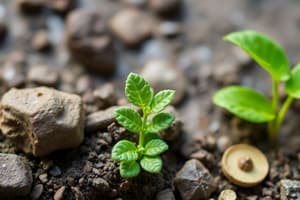Podcast
Questions and Answers
What is ecology?
What is ecology?
Ecology is the study of living organisms and their homes (environments).
What are abiotic components of an organism's environment?
What are abiotic components of an organism's environment?
Abiotic components are non-living factors such as warmth, heat, temperature, moisture, nutrients, and nonliving chemical and physical traits.
What are biotic components of an ecosystem?
What are biotic components of an ecosystem?
Biotic components are the living things that shape an ecosystem, including competitors, predators, mutualists, and commensalists.
Define organismal ecology.
Define organismal ecology.
What is population ecology?
What is population ecology?
What are the factors that affect an organism's distribution?
What are the factors that affect an organism's distribution?
What is biogeography?
What is biogeography?
What is a biome?
What is a biome?
Which of the following are types of aquatic biomes?
Which of the following are types of aquatic biomes?
Which of these factors are main components of climate?
Which of these factors are main components of climate?
What is the relationship between environmentalism and ecology?
What is the relationship between environmentalism and ecology?
What are some practical reasons for studying species distributions?
What are some practical reasons for studying species distributions?
How do ecologists determine population size and density?
How do ecologists determine population size and density?
How does one estimate population size using the mark-recapture method?
How does one estimate population size using the mark-recapture method?
Flashcards are hidden until you start studying
Study Notes
Ecology Overview
- Ecology studies interactions between living organisms and their environments.
- Distinct from environmentalism, which focuses on advocacy, policy, and action for the environment.
Components of Environment
- Abiotic Components: Non-living elements like temperature, moisture, and nutrients.
- Biotic Components: Living entities that influence ecosystems, including competitors, predators, mutualists, and commensalism.
Types of Ecology
- Organismal Ecology: Examines individual organism interactions through morphology, physiology, and behavior.
- Population Ecology: Investigates population dynamics, including growth and decline over time relating to environmental factors.
- Community Ecology: Studies interactions among species in a shared environment, focusing on species competition.
- Ecosystem Ecology: Looks at resource management and interactions of chemical, physical, and biological components within ecosystems.
- Landscape Ecology: Focuses on the spatial arrangement and how human development impacts environments on a larger scale.
Factors Affecting Distribution
- Dispersal: The movement limitations of organisms (e.g., seeds).
- Behavior: Habitat choice influencing presence in an area.
- Biotic Factors: Including predation, competition, and disease impacts.
- Abiotic Factors: Chemical (salinity, pH) and physical (temperature, light) influences.
- Biogeography: The science studying historical and present species distributions.
Biomes Classification
- Biome Definition: Characterized by climate, plant communities, and soil organisms.
- Aquatic Biomes:
- Marine: 3% salt content, crucial for biodiversity.
- Freshwater: 1% salt, vital for many species.
- Streams/Rivers: Flowing water connecting terrestrial environments.
- Wetlands: Transitional areas between land and water.
- Estuaries: Brackish water zones where fresh and saltwater meet.
- Seas/Oceans and Lakes also part of aquatic biomes.
- Terrestrial Biomes:
- Tropical Forests: Rich biodiversity with multiple canopy layers.
- Savannas: Grasslands with scattered trees.
- Deserts: Low rainfall, adapted flora and fauna.
- Chaparral: Fire-prone ecosystems with dry summers and wet winters.
- Temperate Grasslands: Subject to seasonal droughts and fire.
- Temperate Deciduous Forests: Seasonal dormancy in trees.
- Coniferous Forests: Adaptations to cold, featuring gymnosperms.
- Tundra: Cold desert characterized by permafrost.
Climate Components
- Climate elements include temperature, water, wind, and light, which shape ecological environments.
Environmentalism vs. Ecology
- Ecologists focus on scientific research about ecosystems, while environmentalists advocate for natural resource protection and address ecological crises.
Importance of Species Distribution Studies
- Understanding distribution aids in assessing species diversity and how human activities alter ecosystems over time.
Estimating Population Size
- Life Tables: Monitor a cohort's longevity and changes.
- Mark-Recapture Method: Involves tagging individuals to estimate population density through recapture data.
Studying That Suits You
Use AI to generate personalized quizzes and flashcards to suit your learning preferences.




